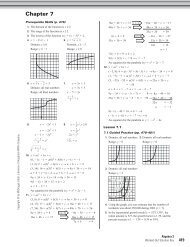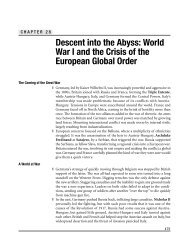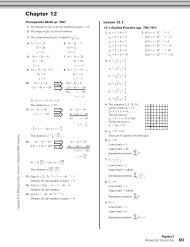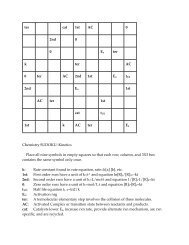Chapter 12 - Investments (91.0K) - McGraw-Hill Higher Education
Chapter 12 - Investments (91.0K) - McGraw-Hill Higher Education
Chapter 12 - Investments (91.0K) - McGraw-Hill Higher Education
You also want an ePaper? Increase the reach of your titles
YUMPU automatically turns print PDFs into web optimized ePapers that Google loves.
Student Date Period<br />
<strong>12</strong>-1<br />
Computing Interest on<br />
Certificates of Deposit<br />
A certificate of deposit (CD) is a type of investment that earns a higher interest rate than a<br />
regular savings account. The only drawback is that you are penalized for early withdrawal. Interest<br />
is compounded daily, monthly, or quarterly, depending on your particular financial institution.<br />
Example<br />
Compute the interest.<br />
Morgana LeFey invests $10,000 into a 4-year certificate of deposit that earns an interest rate of<br />
5.75 percent compounded quarterly. How much interest will she earn at the end of the 4 years?<br />
1. Find the amount using the Amount of $1.00 Invested table on page 180.<br />
Amount Original Principal Amount per $1.00<br />
$10,000 1.256541 $<strong>12</strong>,565.41<br />
2. Find the interest.<br />
Interest Earned Amount Original Principal<br />
$<strong>12</strong>,565.41 $10,000 $2,565.41 interest<br />
Practice<br />
Find the amount and the interest earned. Refer to the Amount of $1.00 Invested table on<br />
page 180.<br />
1.<br />
2.<br />
3.<br />
4.<br />
Annual Interest Original<br />
Interest<br />
Amount<br />
Rate Period Principal Earned<br />
5.50% 4 years daily $ 6,000 a. b.<br />
4.25% 4 years monthly 9,500 a. b.<br />
3.75% 1 year quarterly <strong>12</strong>,000 a. b.<br />
5.00% 1 year monthly 25,750 a. b.<br />
5. Marybeth Evanston can invest $7,500 in a 1-year CD earning 5 percent interest compounded<br />
daily or a 1-year CD earning 5.25 percent interest compounded quarterly. Which rate earns<br />
her more interest? How much more?<br />
6. Felix Capistrano invests $25,000 in a 4-year CD earning 6 percent interest compounded<br />
quarterly. What is the amount at maturity? How much interest does he earn at the end of<br />
the 4 years?<br />
7. Standardized Test Practice Robert and Katie Masterson have the option of investing their<br />
$20,000 savings in a 4-year CD earning 5.00 percent interest compounded daily, 5.25 percent<br />
interest compounded monthly, or 5.50 percent interest compounded quarterly. Which CD<br />
earns the most interest?<br />
A. 5% compounded daily B. 5.25% compounded monthly<br />
C. 5.5% compounded quarterly D. They all earn the same amount of interest.<br />
80 Section <strong>12</strong>-1 Study Guide Copyright © by The <strong>McGraw</strong>-<strong>Hill</strong> Companies, Inc. All rights reserved.
Student Date Period<br />
<strong>12</strong>-2<br />
Determining the<br />
Effective Annual Yield<br />
The annual yield of a CD is the rate at which your money earns simple interest in 1 year. Effective<br />
annual yield is influenced by the frequency of compounding. Yield is the rate of return on your<br />
investment and is usually expressed as a percentage.<br />
Example<br />
Find the effective annual yield to the nearest thousandth percent.<br />
Morgana LeFey invested $10,000 in a 5-year certificate of deposit that earns an interest rate of<br />
5.75 percent compounded quarterly.<br />
1. Find the amount. (Refer to the Amount of $1.00 Invested table on page 180.)<br />
Amount Original Principal Amount per $1.00 for One Year<br />
$10,000 1.058752 $10,587.52<br />
2. Find the interest for 1 year. 3. Find the effective annual yield.<br />
Interest Amount Principal Effective Annual Yield Interest for One Year Principal<br />
$10,587.52 $10,000 $587.52 $587.52 $10,000 5.875% effective annual yield<br />
Practice<br />
Find the amount, the interest earned, and the effective annual yield. (Refer to the Amount of<br />
$1.00 Invested table on page 180.)<br />
1.<br />
2.<br />
3.<br />
4.<br />
Annual Interest Original Interest Effective<br />
Rate Period Principal Amount Earned Annual Yield<br />
5.50% 1 year monthly $ 5,000 a. b. c.<br />
4.75% 1 year daily 9,700 a. b. c.<br />
4.50% 1 year quarterly 11,250 a. b. c.<br />
5.25% 1 year monthly 14,875 a. b. c.<br />
5. Al Holman can invest $15,000 at 5.25 percent interest in a 4-year CD compounded monthly<br />
or quarterly. What is the effective annual yield of each?<br />
6. Marybeth Evanston can invest $7,500 in a 1-year CD earning 3 percent interest compounded<br />
daily or a 1-year CD earning 3.25 percent interest compounded quarterly. Which earns a<br />
higher effective annual yield?<br />
7. Felix Capistrano invests $25,000 in a 4-year CD earning 5.5 percent interest compounded<br />
quarterly. What is the effective annual yield?<br />
8. Standardized Test Practice Robert and Katie Masterson have the option of investing their<br />
$20,000 savings in a 4-year CD earning 5.00 percent interest compounded daily, 5.25 percent<br />
interest compounded monthly, or 5.50 percent interest compounded quarterly. Based on the<br />
annual effective yield, which is the best investment?<br />
A. 5% compounded daily B. 5.25% compounded monthly<br />
C. 5.5% compounded quarterly D. They all earn the same annual effective yield.<br />
Copyright © by The <strong>McGraw</strong>-<strong>Hill</strong> Companies, Inc. All rights reserved. Section <strong>12</strong>-2 Study Guide 81
Student Date Period<br />
<strong>12</strong>-3<br />
Determining the Total<br />
Cost of a Stock Investment<br />
Another way of investing your money is to buy stocks. Purchasing a share of stock makes you a<br />
part owner in the corporation that issues you the stock. A stock certificate represents proof of<br />
ownership. The total cost of your stock depends on the cost per share, the number of shares you<br />
purchase, and the stockbroker’s commission.<br />
Example<br />
Find the total cost of stock.<br />
Morgana LeFey purchased 50 shares of stock at $218.00 per share. If her broker charged her a<br />
1 percent commission on the cost of the stock, what is the total amount she paid for the stock?<br />
1. Find the cost of the stock.<br />
Cost of Stock Number of Shares Cost per Share<br />
50 $218 $10,900<br />
2. Find the broker’s commission.<br />
Broker’s commission $10,900 1% $109<br />
3. Find the total cost of the stock.<br />
Total Paid Cost of Stock Commission<br />
$10,900 $109 $11,009 total cost<br />
Practice<br />
Find the cost of the stock and the total amount paid.<br />
1.<br />
2.<br />
3.<br />
4.<br />
Number of Cost per Cost of<br />
Total<br />
Commission<br />
Shares Share Stock Paid<br />
250 $ 57.00 a. $100.00 b.<br />
100 215.50 a. $250.00 b.<br />
375 41.75 a. 1% of total cost b.<br />
425 132.95 a. $0.18 per share b.<br />
5. Al Holman purchased 75 shares of stock at $37.75 per share. If his broker charged a 1.5 percent<br />
commission on the cost of the stock, what was the total paid?<br />
6. Marybeth Evanston purchased 2,000 shares of stock at $3.15 per share. The broker’s commission<br />
was $29.95 for less than 1,000 shares, or $0.03 per share for 1,000 or more. What was the total<br />
amount Evanston paid for her stock?<br />
7. Felix Capistrano bought 50 shares of shipping stock at $25 per share and 30 shares of airline<br />
stock at $45 per share. The broker’s fee is $15 per transaction. What is the total combined<br />
amount Capistrano paid for his stock?<br />
8. Standardized Test Practice Robert and Katie Masterson bought 99 shares of oil stock at a price<br />
of $55 per share and 150 shares of stock in a steel company at $24 per share. The broker’s commission<br />
is $25 for transactions under 100 shares and $0.20 per share for transactions over 100<br />
shares. What is the total combined amount that the Mastersons paid for both stock transactions?<br />
A. $9,100.00 B. $9,094.80 C. $9,095.00 D. $9,045.00<br />
82 Section <strong>12</strong>-3 Study Guide Copyright © by The <strong>McGraw</strong>-<strong>Hill</strong> Companies, Inc. All rights reserved.
Student Date Period<br />
<strong>12</strong>-4<br />
Computing the Dividend and<br />
Yield of a Stock Investment<br />
A stock dividend is money you receive as a shareholder of the company. The yield, expressed as a<br />
percentage of the price of the stock, is your annual return for holding a stock.<br />
Example<br />
Find the total annual dividend and the annual yield to the nearest thousandth percent.<br />
Morgana LeFey purchased 50 shares of company stock at $147.00 per share. The company paid<br />
annual dividends of $2.97 per share.<br />
1. Find the total annual dividend.<br />
Total Annual Dividend Annual Dividend per Share Number of Shares<br />
$2.97 50 $148.50 total annual dividend<br />
2. Find the annual yield.<br />
Yield Annual Dividend per Share Cost per Share<br />
$2.97 $147.00 2.020% yield<br />
Find the annual yield.<br />
Practice<br />
1.<br />
2.<br />
3.<br />
4.<br />
Annual Dividend Cost per Annual<br />
per Share Share Yield<br />
$0.96 $ 57.72<br />
3.07 191.54<br />
0.75 37.85<br />
1.39 <strong>12</strong>2.63<br />
5. Al Holman purchased 75 shares of company stock at $37.75 per share. Last year the company<br />
paid annual dividends of $1.02 per share. What were Holman’s annual dividends? What was<br />
his annual yield?<br />
6. Marybeth Evanston purchased 2,000 shares of airline stock at $3.15 per share. The company<br />
recently paid annual dividends of $0.09 per share. What are Evanston’s annual dividends?<br />
What is her annual yield?<br />
7. Felix Capistrano bought 30 shares of oil stock at $45 per share. He recently read that the<br />
average selling price of his stock was $51.72. The company paid annual dividends of $1.15 per<br />
share last year. What is his annual yield? What would his annual yield be if he had bought the<br />
stock at its current average selling price?<br />
8. Standardized Test Practice Robert Masterson bought 99 shares of stock at a price of $55 per<br />
share and 150 shares at $52 per share. The annual dividend per share was $1.27. What is<br />
Masterson’s average annual yield?<br />
A. 2.309% B. 2.442% C. 2.374% D. 2.388%<br />
Copyright © by The <strong>McGraw</strong>-<strong>Hill</strong> Companies, Inc. All rights reserved. Section <strong>12</strong>-4 Study Guide 83
Student Date Period<br />
<strong>12</strong>-5<br />
Selling your stock can result in either a profit or a loss. If the amount you receive on the sale<br />
minus the sales commission is greater than the total amount you paid for the stock, then you<br />
make a profit. If it is less than the total amount you paid for the stock, then you suffer a loss.<br />
Net Sale Amount of Sale Commission<br />
Profit Net Sale Total Paid<br />
Loss Total Paid Net Sale<br />
Calculating the Profit or<br />
Loss from a Stock Sale<br />
Example<br />
Find the profit or loss.<br />
Morgana LeFey paid a total of $8,600 for 50 shares of stock. She sold the stock for $170 per share<br />
and paid her broker a sales commission of $15. What is the profit or loss from the sale?<br />
1. Find the net sale.<br />
($170 50) $15 $8,485 net sale<br />
2. Is the net sale greater than or less than the amount paid?<br />
$8,485 is less than $8,600<br />
3. Find the net loss.<br />
$8,600 $8,485 $115 loss<br />
Find the net sale and the profit or loss.<br />
Practice<br />
1.<br />
2.<br />
3.<br />
Total Selling Price Number Net Profit or<br />
Commission<br />
Paid per Share of Shares<br />
Sale<br />
Loss<br />
$ 2,850 $ 60.00 50 $60.00 a. b.<br />
13,<strong>12</strong>5 172.00 75 $75.00 a. b.<br />
5,365 33.50 145 $0.15 per share a. b.<br />
4. Al Holman purchased 75 shares of stock and paid a total of $2,625. He sold the stock at a<br />
price of $36.82 per share and paid a $19 broker’s commission. What was the net amount of<br />
the sale? What was Holman’s profit or loss?<br />
5. Marybeth Evanston purchased 2,000 shares of stock at $3.15 per share. She recently sold the<br />
stock for $3.09 per share. Each transaction carried a broker’s fee of $9.95. What was<br />
Evanston’s net amount of the sale? What was her profit or loss?<br />
6. Standardized Test Practice Robert Masterson bought 150 shares of stock at $52 per share.<br />
He held the stock for 2 years and then sold it for $53.25 per share. His online brokerage fee is<br />
$8.95 plus $0.10 per share. What is Masterson’s profit or loss?<br />
A. $139.60 profit B. $139.60 loss C. $187.50 profit D. $187.50 loss<br />
84 Section <strong>12</strong>-5 Study Guide Copyright © by The <strong>McGraw</strong>-<strong>Hill</strong> Companies, Inc. All rights reserved.
Student Date Period<br />
<strong>12</strong>-6<br />
Computing the Annual Interest and<br />
Annual Yield of a Bond Investment<br />
When you buy bonds you are lending your money to a corporation or the government for a<br />
specified period of time. A bond is a written pledge that you’ll be repaid your money plus interest<br />
at its maturity date (anywhere from 10 to 30 years). How long you keep a bond and how often it<br />
pays interest determines the value of your bond.<br />
Example<br />
Find the annual yield rounded to the nearest hundredth percent.<br />
Morgana LeFey purchased a $7,500 bond at the quoted price of 91 1_ 2. The bond paid an interest<br />
rate of 6.5 percent.<br />
1. Find the bond cost.<br />
Bond Cost Face Value Percent<br />
$7,500 91.5% $6,862.50 bond cost<br />
2. Find the annual interest.<br />
Annual Interest Face Value Interest Rate<br />
$7,500 6.5% $487.50 annual interest<br />
3. Find the annual yield.<br />
Annual Yield Annual Interest Bond Cost<br />
$487.50 $6,862.50 7.10% annual yield<br />
Practice<br />
Find the cost of the bond, the annual interest, and the annual yield.<br />
1.<br />
2.<br />
3.<br />
4.<br />
Face Value Quoted Cost of Interest Annual Annual<br />
of Bond Price Bond Rate Interest Yield<br />
$ 4,000 75 1 4 a. 7.00% b. c.<br />
<strong>12</strong>,000 92 1 2 a. 7.50% b. c.<br />
3,500 102 a. 6.75% b. c.<br />
5,775 1018 5 a. 8.40% b. c.<br />
5. Felix Capistrano purchased 5 bonds at $1,000 per bond and paid a 1 percent brokerage<br />
commission on the principal. The bonds were offered at a quoted price of 101 and earn an<br />
annual interest rate of 7.25 percent. What is the total cost of Capistrano’s purchase? What<br />
total interest will he earn each year?<br />
6. Standardized Test Practice Al Holman purchased a $<strong>12</strong>,000 city bond at a quoted price of 79 1_ 4.<br />
The city board pays annual interest at a rate of 5.8 percent. What is the annual yield on<br />
the bond?<br />
A. 7.29% B. 7.32% C. 7.34% D. 7.36%<br />
Copyright © by The <strong>McGraw</strong>-<strong>Hill</strong> Companies, Inc. All rights reserved. Section <strong>12</strong>-6 Study Guide 85
CHAPTER REVIEW<br />
Student Date Period<br />
<strong>12</strong><br />
<strong>Chapter</strong> Review<br />
<strong>Investments</strong>—Which Type Is Right for You?<br />
In this chapter, you learned that there are other ways to invest your money than in a bank savings<br />
account. The potential for a higher rate of return on your money is much greater, but there are<br />
risks to consider before you invest your money. Which investment is right for you? How much<br />
more interest does one investment earn for you annually than another?<br />
1. You can invest $5,000 in a regular savings account that earns 4 percent interest compounded<br />
quarterly or in a 1-year CD that earns 6 percent interest compounded quarterly. Based on<br />
1 year of interest, which is the better investment?<br />
2. You can invest $5,000 in a 1-year CD or a 4-year CD, both earning an interest rate of 6 percent.<br />
Based on interest alone, which is the better investment? How much more interest does it earn you?<br />
3. What is the effective annual yield, rounded to the nearest thousandth percent, of each of the<br />
CDs in Problem 2?<br />
4. You can invest in either the 1-year CD or the 4-Year CD in Problem 2, but you know you are<br />
going to need your money in 2 years to purchase a new car. There is a large penalty for early<br />
withdrawal. Which is the better investment for you?<br />
5. You buy 50 shares of company stock at $99 per share. There is a $50 broker’s fee. The<br />
company pays an annual dividend of $1.50 per share. What is the annual yield to the nearest<br />
thousandth percent?<br />
6. You sell those same 50 shares of stock for $105 per share. The transaction involves a broker’s<br />
commission of $0.03 per share. What is your profit or loss?<br />
7. You invest your $5,000 in a 10-year bond at the quoted rate of 96 1_ 2. The bond pays an interest<br />
rate of 6 percent. What is the annual interest? What is the annual yield, rounded to the<br />
nearest hundredth percent?<br />
86 <strong>Chapter</strong> <strong>12</strong> Review Study Guide Copyright © by The <strong>McGraw</strong>-<strong>Hill</strong> Companies, Inc. All rights reserved.






